Wednesday, December 9th 2015

AMD Radeon GPUs to Get Major Display Tech Overhaul in 2016
AMD is readying a slew of feature-set additions to its Radeon GPUs, in 2016, targeted at display technology. To begin with, AMD is redesigning FreeSync, its adaptive-sync technology, to work over HDMI. The tech currently requires DisplayPort 1.2a. For this to work, the display should support FreeSync over HDMI on its end, as well. It's not as if every current HDMI display gets adaptive sync. AMD posted a partial list of upcoming displays that support FreeSync over HDMI. With this, AMD is pushing for a new generation of notebooks and convertibles that feature FreeSync displays.
Next up, AMD is implementing high dynamic range (HDR) display support on next-generation Radeon GPUs. Current Radeon GPUs already support 10-bit (30-bit color or 1.07 billion colors, compared to 16.7 million colors on 32-bit); on desktop, Direct3D, and OpenGL apps. HDR will make images look more life-like. AMD claims that 1080p HDR content will look better than 4K SDR (standard dynamic range) content. AMD will also work with game developers to get HDR content on upcoming games.HDR adds data load to existing display interfaces, and so with the next generation Radeon GPUs, AMD is looking to implement DisplayPort 1.3 HBR3, a display interconnect with a raw bandwidth of 32.4 Gb/s, 80% higher than HDMI 2.0, which will enable 5K (5120 x 2880 pixels) at 60 Hz, over a single connector at SDR; 4K (3840 x 2160 pixels) at 120 Hz SDR or 60 Hz HDR, 3K (3440 x 1440 pixels) at 190 Hz with SDR and 144 Hz HDR; WQHD (2560 x 1440 pixels) at 240 Hz SDR and 170 Hz HDR; and FHD (1920 x 1080 pixels) at 240 Hz on both HDR and SDR.
Next up, AMD is implementing high dynamic range (HDR) display support on next-generation Radeon GPUs. Current Radeon GPUs already support 10-bit (30-bit color or 1.07 billion colors, compared to 16.7 million colors on 32-bit); on desktop, Direct3D, and OpenGL apps. HDR will make images look more life-like. AMD claims that 1080p HDR content will look better than 4K SDR (standard dynamic range) content. AMD will also work with game developers to get HDR content on upcoming games.HDR adds data load to existing display interfaces, and so with the next generation Radeon GPUs, AMD is looking to implement DisplayPort 1.3 HBR3, a display interconnect with a raw bandwidth of 32.4 Gb/s, 80% higher than HDMI 2.0, which will enable 5K (5120 x 2880 pixels) at 60 Hz, over a single connector at SDR; 4K (3840 x 2160 pixels) at 120 Hz SDR or 60 Hz HDR, 3K (3440 x 1440 pixels) at 190 Hz with SDR and 144 Hz HDR; WQHD (2560 x 1440 pixels) at 240 Hz SDR and 170 Hz HDR; and FHD (1920 x 1080 pixels) at 240 Hz on both HDR and SDR.
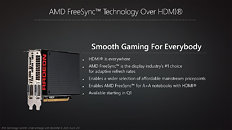
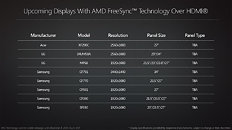
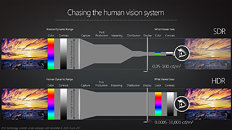
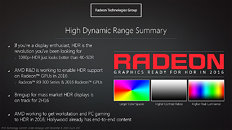
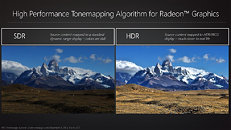
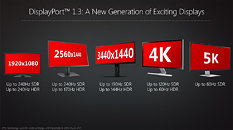
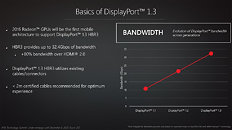
15 Comments on AMD Radeon GPUs to Get Major Display Tech Overhaul in 2016
I love the idea and someone has to start somewhere, but unless they make really good deals and aggresively push the tech, it'll take at least 5 years for anything to start moving anywhere.
@Eroticus not everyone has the money to get crazy good cards and not to mention the 780 is a fine card.
Only "prof" space HDR monitors are available.
Naturally there were many people defending this omission in forums stating they would never use HDMI anyway. This then suggests that AMD is banking on technology that many people don't want and would never use even if they could.
I see one major thing on this tha actually peaks my interest. Freesync support on notebooks which would be fantastic as I think G-Sync notebooks is a very cool thing so now we will have competition in that area. Though we need more notebook GPU's before that...
DP is The Future™.
Sony XBR55X850C
Sony XBR75X910C
Sony XBR65X930C
Samsung UN60JS7000
Samsung UN65JS8500
LG Electronics 55EF9500
meanwhile the nvidia pascal slides :/ .
- 10x performance
- 16Gb hbm..
- blablabla...